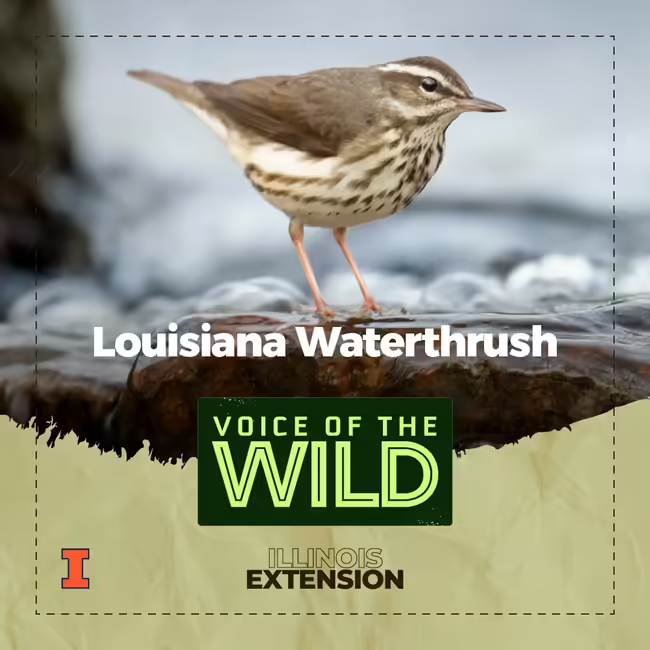
Episode Number
49
Episode Show Notes / Description
Louisiana waterthrush (Parkesia motacilla).
The early warbler that favors muddy shorelines.
Do you want to learn more bird songs, frog calls, and insect noises? Join Voice of the Wild every Friday to explore a new wild voice. We’re available on most podcast platforms, including Apple Podcasts, Spotify, and YouTube.
- Subscription links Here
- Subscribe to the Newsletter
- Listen online on our Homepage
The following Cornell Lab | Macaulay Library recordings were used in this episode:
- Louisiana waterthrush song by Wil Hershberger (ML508939)
- Louisiana waterthrush song by Wil Hershberger (ML508938)
- Louisiana waterthrush call by Robert C. Stein and Randolph Little (ML508943)
Sources and more:
- https://www.allaboutbirds.org/guide/Louisiana_Waterthrush
- https://www.audubon.org/field-guide/bird/louisiana-waterthrush
- Dobson C, Kassenbaum D, Oehmke D, et al. 2023. Field guide to hotspots and birds in Illinois. Champaign-Urbana: Scissortail LLC.
- National Audubon Society videoguide to the birds of North America. 2004. Fullscreen. Carrboro, NC: Godfrey-Stadin Productions.
- Sibley D. 2016. Sibley birds East : field guide to birds of eastern North America. Second edition. New York: Alfred A. Knopf (Field guide to birds of eastern North America).
- Stokes DW, Stokes LQ. 2004. Stokes Field Guide to Warblers. 2nd ed. New York: Little, Brown (Stokes field guides).
Transcript
This is Illinois Extension’s Voice of the Wild. A new wild voice in just a moment, so find someplace quiet, take a deep breath, and enjoy.
A warbler of the water’s edge, be that edge on a bubbling steam, flowing springtime brook, or flooded riverside woodland. It is a bolt of brown and white with a surprisingly aggressive demeanor; ready to defend its territory and hunting space from interlopers in the flash of a wing. Its most notable behavior is the habitual semi-circular pumping up and down of its tail as it hops and flutters about a muddy shoreline searching for aquatic arthropods.
This is the Louisiana waterthrush (Parkesia motacilla) from the family of the wood-warblers, Parulidae
The song of the louisiana waterthrush ends with a flourish but it starts with a repeating preface; “weeyou weeyou weeyou”. Its plumage is somewhat dull compared to many other warblers, but its bold white eyebrow is nonetheless handsome and its pinkish legs cute.
The Louisiana waterthrush has a sibling that, while sounding very different, looks almost identical - the northern waterthrush. While these two species will eventually settle down to breed in largely isolated ranges, during migration they can both be seen in illinois - I will eventually do a comparison episode between the two birds, but for now just know this: the Louisiana waterthrush, the focus of this episode, is the first of the two to migrate in the spring, so a bird found in March or very early April will generally be a louisiana. The northern won’t arrive until about mid april. Here’s the Louisiana waterthrush again.
Thank you to the Macaulay library at the Cornell lab for our bird sounds. And thank you for tuning in to learn a new wild voice with Illinois Extension.
A warbler of the water’s edge, be that edge on a bubbling steam, flowing springtime brook, or flooded riverside woodland. It is a bolt of brown and white with a surprisingly aggressive demeanor; ready to defend its territory and hunting space from interlopers in the flash of a wing. Its most notable behavior is the habitual semi-circular pumping up and down of its tail as it hops and flutters about a muddy shoreline searching for aquatic arthropods.
This is the Louisiana waterthrush (Parkesia motacilla) from the family of the wood-warblers, Parulidae
The song of the louisiana waterthrush ends with a flourish but it starts with a repeating preface; “weeyou weeyou weeyou”. Its plumage is somewhat dull compared to many other warblers, but its bold white eyebrow is nonetheless handsome and its pinkish legs cute.
The Louisiana waterthrush has a sibling that, while sounding very different, looks almost identical - the northern waterthrush. While these two species will eventually settle down to breed in largely isolated ranges, during migration they can both be seen in illinois - I will eventually do a comparison episode between the two birds, but for now just know this: the Louisiana waterthrush, the focus of this episode, is the first of the two to migrate in the spring, so a bird found in March or very early April will generally be a louisiana. The northern won’t arrive until about mid april. Here’s the Louisiana waterthrush again.
Thank you to the Macaulay library at the Cornell lab for our bird sounds. And thank you for tuning in to learn a new wild voice with Illinois Extension.